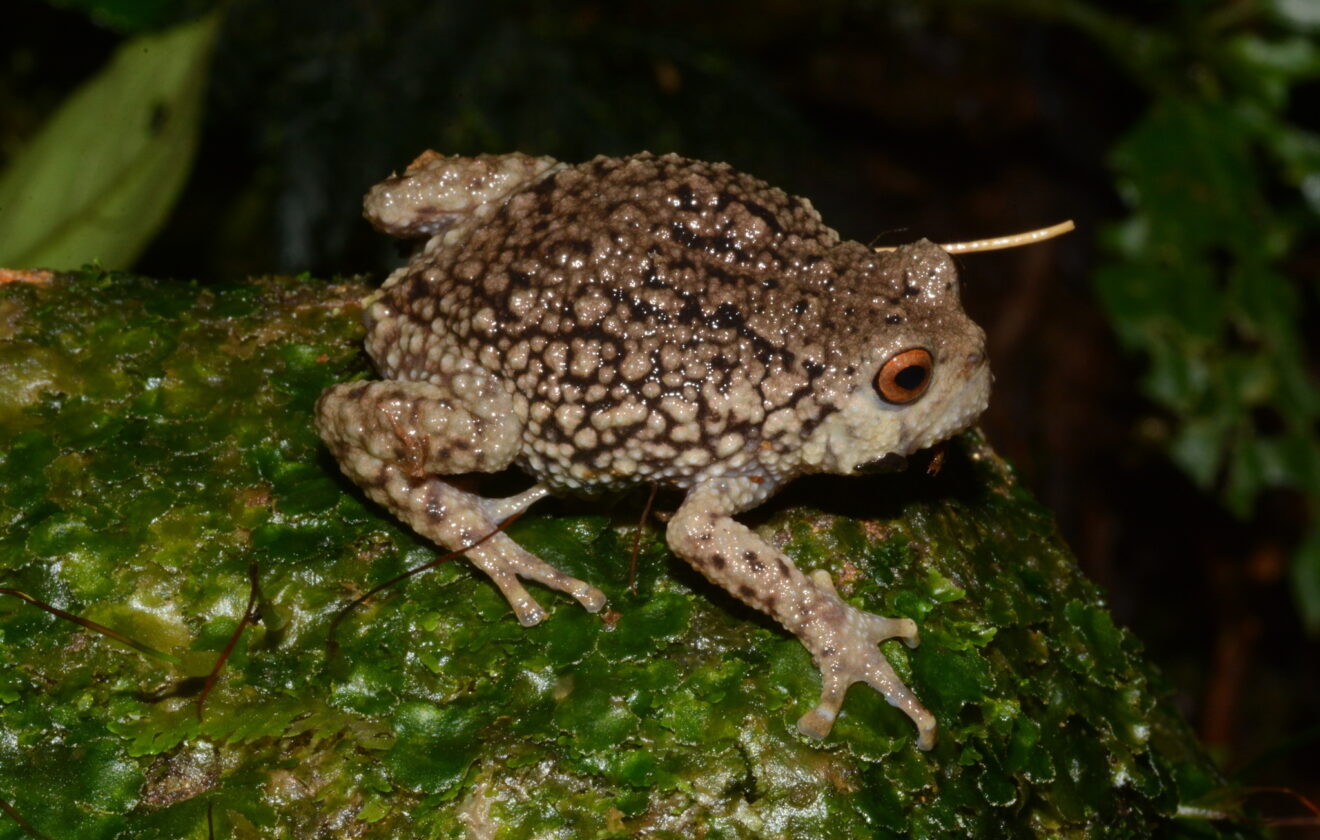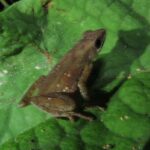- Discovering Callulina hanseni: Tanzania's Enigmatic Hansen's Warty Frog
- The Scientific Identity: Taxonomy and Classification
- A Hidden World: Exploring the Habitat of Callulina hanseni
- Incredible Adaptations: Physical Traits of Hansen’s Warty Frog
- The Silent Lives: Behavior and Reproduction of Callulina hanseni
- A Vital Cog in the Ecosystem: The Ecological Role of Hansen’s Warty Frog
- Silent Struggle: Conservation Challenges Facing Callulina hanseni
- Cultural and Scientific Footprints of Callulina hanseni
- A Call to Conservation: Preserving the Enigmatic Hansen’s Warty Frog
Discovering Callulina hanseni: Tanzania’s Enigmatic Hansen’s Warty Frog#
Beneath the lush, mist-veiled canopy of Tanzania’s Eastern Arc Mountains, amidst the bronze-colored fallen leaves and emerald moss carpets, resides a frog which remains largely hidden, a marvel of evolutionary uniqueness and ecological importance—the fascinating Callulina hanseni. Known more commonly as Hansen’s Warty Frog, this comparatively lesser-known amphibian captivates not just with its cryptic appearance and intriguing lifestyle, but with the significant ecological story it quietly unfolds each day.
Despite not boasting of bright poisonous hues or melodious calls attracting casual attention, Callulina hanseni thrives almost unseen, gently reminding nature enthusiasts and conservationists alike how the quietest species often have the greatest secrets to share. But what can this frog tell us about biodiversity, conservation, and the mysterious world of Tanzania’s ancient forests? Journey with us as we venture deeper to unveil the truth behind Callulina hanseni’s enigmatic life.
The Scientific Identity: Taxonomy and Classification#
Known scientifically as Callulina hanseni, this remarkable species belongs to the family Brevicipitidae, commonly referred to as rain frogs or short-headed frogs. The genus Callulina itself harbors an array of unique and confined amphibians primarily native to Tanzania, each adapted beautifully to living amidst leaf litter and damp forests. First described by Loader and colleagues in 2010, Hansen’s Warty Frog is a relatively recent addition to herpetological knowledge—a poignant reminder of Earth’s vast pockets of uncharted biodiversity.
Hansen’s Warty Frog, named in honor of Dr. Dennis Hansen, a conservation biologist whose work greatly advanced knowledge about the amphibians of Eastern Africa, underlines the importance of continued exploration in biodiversity hotspots—areas where every new discovery rewrites our understanding of life on Earth.
A Hidden World: Exploring the Habitat of Callulina hanseni#
Stretching along the undulating hillsides of Tanzania’s Eastern Arc Mountains, the habitat of Callulina hanseni is nothing short of enchantment. Surrounded by lofty trees and abundant rainfall, shrouded frequently in delicate mist, these pristine cloud forests provide an ideal sanctuary for this amphibious treasure. Specifically, Hansen’s Warty Frog inhabits mid-altitude montane forests situated between 900 and 1,700 meters above sea level, sheltered beneath the dense foliage and leaf litter.
This thick carpet of decomposing leaves and fallen branches, occasionally punctuated by soft patches of moss, is not simply a casual hiding place; it represents a vital ecological niche painstakingly adapted to by the frogs throughout their evolutionary journey. Favoring regions of stable humidity and temperature, these enchanting amphibians are fine-tuned indicators of environmental health and stability. As they nestle amongst decaying vegetation, they actively exemplify the critical functions of healthy forests in nutrient cycling, biodiversity, and ecological balance.
The Most Delicate of Ecosystems#
The geographical reach of Callulina hanseni remains remarkably limited, making it an endemic species tied closely to the ecological fate of the Eastern Arc Mountains themselves. Their habitats demand uninterrupted forest canopies, abundant leaf litter, and unpolluted moisture-rich air—conditions increasingly threatened by human encroachment, agriculture, and climate change.
Incredible Adaptations: Physical Traits of Hansen’s Warty Frog#
Picturing a Callulina hanseni might come with its challenges at first, especially as the frog is neither conspicuously vibrant nor exceptionally large. However, those fortunate enough to encounter this small amphibian express awe at its uniquely adapted physique. Usually growing no larger than 35 millimeters in length, Hansen’s Warty Frog proudly displays stout limbs, short snouts, and rounded bodies—a morphology remarkably suited to leaf-litter dwelling.
The surface of the frog is covered richly in wart-like protuberances and small tubercles, giving Hansen’s Warty Frog both their common name and a unique camouflage helping them vanish effortlessly among textured leaves and bark. Their coloration expresses a striking range of browns, olives, and gentle earth tones—nature’s perfectly designed palette to blend and thrive unnoticed amidst leaf litter and forest debris.
The Silent Lives: Behavior and Reproduction of Callulina hanseni#
If forests could speak, they might whisper accounts of frogs like Callulina hanseni, spending their days hidden discreetly beneath the canopy, their presence betrayed only occasionally by faint, quiet calls during breeding periods. Unlike their brightly colored tree-frog cousins, their subtle, muted existence prioritizes subtlety and shelter, shunning the spotlight for security amidst leaf litter and moist ground.
Hunters in the Leaf-Litter#
Beneath layers of leaves and damp soil hides a world teeming with small insects, termites, ants, and beetles—perfect prey and staples for Callulina hanseni. Unlike acrobatic hunting frogs that pounce on prey in open view, Hansen’s Warty Frogs rely on subdued and patient predation tactics, snatching passing insects with steady, calculated strikes of their tongues, blending into their surroundings and patiently awaiting their nourishing meals.
A Unique Reproductive Cycle#
Another striking adaptation of Hansen’s Warty Frog is their direct development reproductive strategy. Unlike traditional amphibians who create aquatic tadpole stages, species of the genus Callulina, including C. hanseni, lay small clutches of eggs in carefully concealed terrestrial sites. As the moisture-rich leaf-litter protects and incubates these precious lives, fully formed miniature froglets hatch directly from the eggs, bypassing the vulnerable tadpole stage altogether. This fascinating strategy reflects an adaptation to stable humidity and enables the frog to bypass the perils of vulnerable aquatic-based life stages.
A Vital Cog in the Ecosystem: The Ecological Role of Hansen’s Warty Frog#
Though small in stature, the ecological role Callulina hanseni fulfills warrants deep consideration. Amphibians like these frogs serve as essential components in maintaining ecological balance within their small, biodiverse territory. As predators consuming important numbers of insects and termites, they indirectly manage insect populations and thus support forest health.
Simultaneously, their sensitive skin and particular habitat requirements position them as true indicator species, helping ecologists recognize early signs of environmental trouble long before the impacts visibly damage broader wildlife communities. With their relatively narrow survival parameters, even slight shifts in temperature, humidity, or habitat quality significantly impact Hansen’s Warty Frogs, illuminating issues often invisible to the casual observer.
Silent Struggle: Conservation Challenges Facing Callulina hanseni#
It is an unfortunate reality that Callulina hanseni holds a place on the International Union for Conservation of Nature’s (IUCN) Red List as an Endangered species. Persistent habitat destruction caused by agriculture practices, logging, and human settlement expansion threaten the delicate balance necessary for sustaining them in their limited geographical niche. The threat is augmented by climate change-induced shifts in rainfall and humidity, conditions these frogs closely depend upon.
In response to these threats, conservation biologists and local environmental advocates rally vigorously. Efforts include habitat protection programs, community involvement in conservation initiatives, and ongoing population monitoring designed to mitigate immediate threats and secure Callulina hanseni’s uncertain future.
Cultural and Scientific Footprints of Callulina hanseni#
Although not widely recognized culturally as some larger iconic species, Callulina hanseni embodies the sense of wonder and mystery fundamental to biodiversity hotspots. Named in gratitude of dedicated conservation researchers, its discovery underscores the critical importance of continued field studies and collaborations between local communities, scientists, and conservationists alike.
A Call to Conservation: Preserving the Enigmatic Hansen’s Warty Frog#
Callulina hanseni, hidden beneath the layers of Tanzania’s hidden cloud forests, reminds us that Earth’s biodiversity relies as much upon species quietly hidden from sight as it does upon magnificent giants we praise openly. Understanding the delicate intricacies shaping this humble frog’s existence fuels awareness and advocacy, urging conservation-minded readers, students, nature enthusiasts, and even casual observers to become active protectors of biodiversity everywhere.
By embracing the story of Hansen’s Warty Frog, we deepen our understanding, respect our environment’s complexity, and champion the protection of a species whose silent life speaks volumes.








